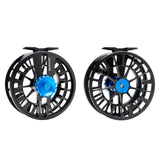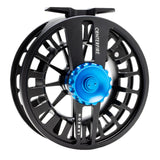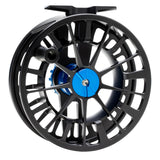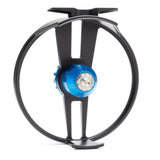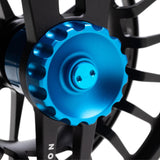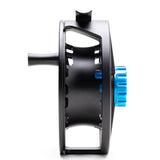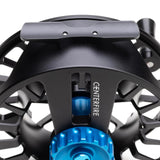Lamson Centerfire Fly Fishing Reel
It's Centerfire...not Centrefire...but we added the AU/NZ spelling to help if you were searching for it.
In designing the Centerfire, Lamson drew from the strongest and most reliable elements from over a quarter century of fly reel production. The frame incorporates our proprietary—IPX8 waterproof rated—Cobalt drag system, burly Power Arm construction, and load path reinforcement. The spool maximizes capacity and line retrieval with plenty of porting to dry out after a big day. Add a large fluted drag knob, oversized handle, and hard anodize and you can be sure this reel will only clock out when you do.
Available in Eclipse - pictured.
Specs
| SIZE | DIAMETER | WIDTH | WEIGHT | ROD WEIGHT |
MAX LINE |
BACKING CAPACITY |
|---|---|---|---|---|---|---|
| 8 | 4" | 1.10" | 6.7 oz | 7.8 | WF8 | 250 yds 20# |
| 10 | 4.35" | 1.15" | 7.8 oz | 9.10 | WF10 | 250 yds 30# |
| 12 | 4.7" | 1.25" | 8.9 oz | 11.12 | WF12 | 300 yds 30# |
Additional Info
- Large arbor format
- IPX8 Certified Waterproof
- Cobalt hybrid drag system
- Large format drag cone
- Carbon PEEK thrust washers
- Custom self-lubricating o-ring seals
- Fixed spindle design
- Zero-lash stainless steel roller clutch
- Large easy grip drag knob and handle
- Locking spool nut
- Integrated counterbalance
- Signature Power Arm frame
- Deep cross-section radial spool spokes
- Hard anodized
- US made drag
- Assembled in the US
Removing the Spool
Q – How do I remove the spool on my reel?
Important: do not remove the drag knob or the black nut with two small holes in it.
A – Hold the reel in your hands with the drag knob facing you. Place your finger tips around the edge of the reel case and place your
thumbs in the ports against the spool. Push the spool away from the case. You will feel the reel “click” as the o-ring unseats from its groove. Withdraw the spool from the body.
Please watch our instructional video that will visually walk you through this process.
Reel Maintenance and Care
Waterworks-Lamson Reel Maintenance and Operation from Waterworks-Lamson on Vimeo.
Our warranty is valid for the lifetime of the original purchaser of this reel against any defect in material or workmanship. This warranty applies to parts and labor, and does not cover damage due to misuse, improper maintenance or modification. This warranty is limited to repair or replacement at our option. We will fix and ship your reel promptly so that you may enjoy fishing with your Lamson reel.
*Note: Repair parts or color may not match the original reel.
C1 Design Group: The Roots of Lamson
Lamson is not a typical fly fishing company. We are C1 Design Group, and our core expertise is in product design. We innovate, invent, design and engineer. Our roots trace back to the bicycle industry, where we designed one of the very first (and very best) clipless pedal systems. In the early 90’s, we tackled the hardest challenge in mountain bike design: creating suspension systems that would perform at the cutting edge in all conditions and on all terrains.
We helped reinvent the wheel, or at least front suspensions, for Cannondale bicycles. The idea was to eliminate the excess weight and variable flexing of the standard telescopic fork suspension, which was a hand-me-down from the motorcycle. The work done by C1 Design came to market on Cannondale bikes first under the name “Delta V”, and later as the “Headshok”. The Headshok was an innovative suspension system that resided in the head-tube of the bike, reducing weight and providing the steering precision and stability of a rigid fork.
We then helped Kestrel, a top quality manufacturer of carbon fiber road bikes, to introduce a dual-suspension mountain bike. We designed the Kestrel Rubicon mountain bike which received immediate high praise and enthusiasm despite its $3,800 price tag. The Rubicon Comp won the prestigious Mountain Bike Magazine “Best Downhill Bike” award in ’97. Our design contribution to the Kestrel Rubicon was total: the Rubicon utilized our patented dual-rate rear suspension system, and embodied our complete frame design.
 C1 Design Group enters fly fishing as the Waterworks: 1995 to 1998
C1 Design Group enters fly fishing as the Waterworks: 1995 to 1998
Ketchum Release We began to develop product ideas and explore the fly fishing market in 1995. After a long weekend with dead fish in the bathtub, designer Mark Farris emerged with a tool capable of reducing fish mortality by eliminating netting and handling. We called this the Ketchum Release, a play on the name of our home town of Ketchum, Idaho. It was an immediate success.
Following the Ketchum Release and several other accessory ideas, we quickly turned our attention to fly reels. We could see that fly reels were poorly designed. Reels were too complicated; they were using too many parts; drag systems and other running parts were exposed to the elements; reels were too heavy. We began with a blank sheet of paper, and undertook a total re-think of the fly reel.
Center Axis Concept
To “quiet” the negative influence that the weight of a reel has on the rod, the ultimate solution would be to align the center of mass of the reel with the center axis of the rod. By aligning these two centers of mass along the same axis, the twisting or pronating force would be eliminated and the pendulum effect reduced. The rod would be in better balance, feel more responsive, and perform according to the rod designer’s vision. 1999
Late in 1998, we acquired Lamson. Lamson reels had established a well-deserved reputation in the 1980’s and 90’s for being the first fully machined quality reel at an affordable price. The “LP” design became the standard of it’s time and sold for a very reasonable price of $200.
With the acquisition of the Lamson trademark, and the design work for Sage under our belt, we were ready to bring our own line of reels to market.
Designing a Reel: Let’s Start With Design Objectives
When we set out to design our own reels, we started by evaluating not just the reel, but the rod/reel system. As we discussed, observed and evaluated rod design at the world’s leading rod manufacturers, we quickly came to the conclusion that reels were too heavy. We needed to lighten reels in order to keep pace with the ever-lighter rods and to eliminate the negative impact that a reel has on a rod’s casting performance. Call this our first objective: reduce physical weight.
Another objective was to simplify the design of a reel. With any mechanical device, simplicity is a virtue. We saw reels with 80+ parts. It is easy to make something with too many parts; it’s hard to make something work with fewer parts. Simplicity means that there is less that can go wrong, can result in the virtue of less physical weight, and moreover, often becomes the catalyst for an elegant design solution.
A third objective was to optimize large arbor benefit. The world is full of reels that call themselves “large arbor” but whose bark in this regard is louder than their bite. Call these reels mid-arbor. We believe in the virtues of large arbor: faster retrieve rate, constant drag tension and elimination of coil memory. So we set out to maximize the benefits.
We felt that we could bring a better reel to market by using superior materials and processes. Much advancement has been made in the past 2,000 years, even the past 10 years, that were not being applied to fly reels to make them perform better.
Finally, we set out to design the world’s best drag system. This meant zero start-up inertia. It meant silk-smooth through the entire torque range. It meant top-end torque sufficient to stop what you catch. It meant that the drag would perform exactly the same under all conditions that one met in real life: water, sand, dirt. It meant that you shouldn’t have to think about your drag, ever. No cleaning or lubrication required.
And so our objectives were clear:
- Reduce physical weight
- Achieve mechanical simplicity
- Maximize large arbor benefit
- Utilize superior materials
- Create the world’s best drag system
Design Objective: Reduce Physical Weight
The gravity-defying Waterworks ULA, world’s lightest machined reel.
The gravity-defying Lamson ULA, world’s lightest machined reel.Rods had gotten lighter. Reels had not. How much did a 5-wt. rod weigh ten years ago? Five ounces? Five and a half ounces? How much did a reel weigh? About the same.
Now rods weigh almost 50% less than they did ten years ago. When we began this project, trout reels still weighed five ounces and more. Reels had become the 350-pound passenger in a finely tuned Lotus. It became time to get a lighter passenger.
How do you reduce the weight of the reel? There were a number possible approaches to choose from: reduce overall size; reduce material usage; use lighter materials; create a lighter structural format; reduce the weight and number of components.
Obviously, to build a large arbor reel, the first option was not a practical consideration. But each other directive held promise.
We reduced material usage by careful and precise engineering and machining, leaving material only where it provided structural strength, carving every gram from non-critical areas.
We made bold (and expensive) material choices employing titanium where other manufacturers used steel, polymers instead of wood and cork.
We invented a structure that would free the reel from the bulkiness of traditional designs. Key to this process was a drag system that, unlike a disc, wouldn’t dictate a particular and restrictive geometry for the reel. The development of the conical drag was therefore integral to building what would seem to be an engineering paradox: Bigger yet lighter.
Lastly, we shaved grams off each individual component through testing, evaluation, re-design and refinement.
Design Objective: Achieve Mechanical Simplicity
Tear apart a reel today, and be prepared for the horror of finding 80 to 100 parts. Thingamajigs connecting the whatsit to the whoseyourdaddy. They can look like an eighth grade science project. Sporting a whopping 23 parts, the ULA aptly demonstrates the adage of form following function. And every once in a while the quest for simple design can result in something unexpected: A form that becomes so succinct that it may approach the compact beauty of a poem.
Two examples to illustrate our approach to simplicity. Imagine the typical fly reel counterbalance; a slug of metal and a screw opposite the handle. Take a look at the ULA spool face above. Where’s the counterbalance? The asymmetry of the spoke provides the mass to balance the handle. Two parts down, but what’s more, this form becomes one of the signature aesthetic elements of the reel.
Another example of mechanical simplicity is our spool latching mechanism. On other reels, the latching mechanism involves a button or a lever that activates springs & plates that grab and hold the spool onto the frame. These represent ten to fifteen parts that create an opening for contaminants to enter the running gear of the reel, and ten to fifteen parts that can fail in time. All of our reels use a simple but effective o-ring lock that serves two purposes: to lock the spool to the frame and to seal the drag chamber. This lock is achieved using no extra parts. The spindle flair passes over an o-ring at the entrance to the drag chamber and then locks into a groove machined into the drag cap. We eliminate parts, eliminate liabilities, serve two functions, create virtues. Simple.
Design Objective: Maximize Large Arbor Benefit
History – Traditional Arbor Reels
Traditional Arbor ReelsThere are those who minimize the importance of a reel by saying “it just holds line”. But how a reel stores line has everything to do with performance. Line stored in deep, narrow reels will develop coil memory; drag tension will increase as line is pulled from the spool on long runs; and line retrieval is an exercise in frustration. Traditional storage formats can be seen in the reels below. Can you get any narrower and deeper than the wooden example from 1889? But look at the advancements made in design by 1913: reels were carved from metal, they had standard reel feet, they had counterbalances smaller than your fist, they even came in a box! But they still had deep, narrow storage for line. And just look at the advancements in small arbor designs in the 98 years since 1913!
The traditional small-arbor storage format, with its unavoidable liabilities, was the state of the art from the beginning of time until the mid-1990’s.
First Generation “Large Arbor” Reels vs. True Large Arbor Reels
In the early 1990’s the first generation of “large arbor” reels were introduced. While representing an advancement over traditional storage formats, and solving some of the maintenance and drag problems associated with earlier reels, these reels actually offered only minimal improvement over traditional arbor reels. For all practical purposes they can be thought of as “mid-arbor” reels, and these formats are still the most common found in the market.
The Lamson Ultra Large Arbor (ULA)A true large arbor format drastically increases the width of the spool and can therefore increase the arbor diameter significantly without reducing line and backing capacity. Ideally it must do these things without being heavier. If so, then the result is a maximization of the benefits of large arbor design.
Design Objective: Utilize Superior Materials
Titanium (Ti) is the 22nd element in the Periodic Table. It may not look like much when it is in raw pellet form, but Titanium is very impressive when machined into reel parts. We use titanium where applicable in the ULA reels. Stronger than stainless, virtually inert, and weighing about 35% less, it is a costly and worthy alternative. In instances where stainless is more appropriate, we chose exotic, high strength “super alloys” like 17-4 PH rather than the typical, far weaker 302 or 303 found in other reels.
Design Objective: Utilize Superior MaterialsOur reels and this tank have more in common than you might imagine. Both use a form of anodizing that is very hard and exceptionally wear resistant: type 3 hard anodize.
Anodizing is an electrolytic process for producing controlled aluminum oxide films on aluminum. Oxide forms naturally on untreated aluminum but the anodizing process produces a coating which is uniform, harder and more dense than natural oxidation.
Virtually every other reel uses a decorative finish called type 2 anodize. Type 2 allows for the use of a variety of colors and brightness, but it is a thin and easily penetrated surface. Type 3 hard anodize surfaces are thicker, with surface hardness and abrasion resistance as their primary characteristic. Type 3 finishes are produced using special anodizing conditions that limit the use of dye. Since type 3 anodizing produces far superior protection, why are we the only reel to use type 3 hard finishes? Again, we can only guess that it’s because the process is expensive, it’s demanding, and it limits color choice. It’s not the easier path. But it’s the path to better results.
Design Objective: Create the World’s Best Drag System
The Common Disk Drag
Why are virtually all drag systems based on rotating disks? Because it’s easy. Call up the company that makes the disks shown on the left. Want cork? Want plastic? Place your order and it shows up in three days. But there are a few problems with this common approach.
The first problem is associated with the disk shape itself. A typical approach is to use two disks (one stationary, one rotates). But the disks need to be large in order to have the surface area required to generate stopping power. Once a disk is large it cannot be sealed from the elements, and this exposure brings with it a long list of other problems.
To address this problem, we reshaped the traditional disk drag into two mated cones. By doing so, we are able to take advantage of a large surface area for torque, but we reduce the overall diameter of the system so it could be fitted into a sealed chamber. The male cone is precisely machined to mate with a female cone; the male rotates while the female remains stationary.
The Common Disk DragThe male conical element is a polymer alloy with an extremely low co-efficient of friction, and the female element is a Teflon impregnated metallic surface. The male cone has a very low co-efficient of thermal conductivity, meaning it conducts heat very slowly. The female cone, which is part of the frame, conducts heat very quickly. Thus, when heat is product by friction it is “wicked” off the male cone and out through the frame. The polymer alloy and Teflon/metal cones run without any oil or grease; thus no maintenance is required to keep the drag system performing at it’s best. And because the drag parts require no lubrication, don’t wear, and are fully sealed, the fisherman will never experience a change in performance and will never be burdened with cleaning, lubricating or maintaining the drag in any way.
Differences Among Lamson Reel Models
The Vanquish and Lamson ULA designs represent our undiluted design vision. No compromises were made in materials or design. The result is lightweight, high performance and beautiful. But they don’t come cheap. The Lamson Litespeed was designed to bring as many of the Vanquish and ULA performance benefits to a more affordable reel. We achieved this by changing the structure and moving from titanium to stainless, yet were able to keep all other features of the ULA.
Important: Do not remove the drag knob or the black nut with two small holes in it.
First, with the drag knob facing you, remove the spool (by holding the edge of the case with your fingers push your thumbs through the ports of the case and push the spool out). Put the spool aside. Holding the frame/case in your hand, unscrew the black cap with gear teeth at the end of the center cylinder. The clutch should fall out (tap lightly on flat surface if necessary). Flip the clutch over and reinstall. Female notches on the clutch must fit into male notches inside the cylinder. To ensure the clutch is fully seated and notches are properly engaged, use your pinky, ball point pen or similar clean tool to rotate clutch as necessary. Reinstall the cap by hand.
Please watch our instructional video that will visually walk you through this process.
LINE STORAGE FORMAT
Our large arbor reels maximize the benefits of large arbor design by maximizing the arbor diameter-to-width ratio. The spool is large in circumference and wide, so that line is stored in a shallow layer. The increased circumference provides high retrieve rate and eliminates line coil memory. The wide, shallow line layer means there is little radius change as line is pulled form the reel. This results in constant drag torque during long runs and eliminates the risk of tippets breaking due to drag force gain.
HARD ALOX FINISH
All of our premium reels (Vanquish, ULA, Litespeed and Velocity) are offered in one fantastic finish only -- a proprietary combination of alloy selection and conversion coating that we call “Hard Alox”. The term Hard Alox is taken from the anodizing process itself, wherein the aluminum surface is converted to aluminum oxide. By increasing the coating thickness and reducing porosity, our Hard Alox coating is much more durable than any other reel. Ask a dealer for a demonstration and prepare to be impressed. Hard Alox trumps the conventional and ubiquitous Type 2 anodize, a finish which emphasizes gloss and color selection over durability. In place of Type 2 we offer you enhanced resistance to abrasion, impact and corrosion and a look that tells the story of beauty which, while not being just “skin deep”,
actually does start there.
DRAG SYSTEM
The drag system in all of our reels consists of a pair of precisely matched conical elements which are drawn together with spring tension to produce variable rates of smooth rotational braking. By re-configuring the surface area of traditional disks into a pair of matching conical elements we were able to seal the drag completely from moisture, salt and grit. And since the mass of the drag elements is centralized, the spool's rotating mass is much lower which makes the reel more responsive to light drag settings. Because the average radius of the contact surface is much smaller (being conical rather than disk-shaped), start-up torque is too low to measure. US Patent #5,915,639;
other patents pending.
CLUTCH
Most premium reels rely on a pawl type clutch mechanism. These are often vulnerable to stress related failure, contamination and wear. All of our reels employ a Torrington zero-lash roller clutch. This mechanism relies on the locking effect of a number of ramps and rollers to achieve torque transmission. There are no "teeth" or "steps" to break off or wear out. And the zero-lash feature means instant engagement. This improves feel and eliminates "spike" that the reel, line and leader experience when a typical pawl clutch hooks up.


